Cross-Border Sand and Dust Storms between Mongolia and Northern China in Spring and Their Driving Weather Systems
Abstract
1. Introduction
2. Materials and Methods
2.1. Data
2.2. Methods
3. Results
3.1. Identification of Cross-Border SDSs
3.2. Statistical Characteristics of Cross-Border SDSs
3.3. Different Types of Weather Systems Associated with Cross-Border SDSs
3.4. Different Types of Weather Systems: Three Typical Examples
3.4.1. MC-Dominant Type
3.4.2. MC-CH Type
3.4.3. Cold Front Type
4. Conclusions and Discussion
- (1)
- The spring cross-border SDSs between Northern China and Mongolia during 2000–2023 have been identified and documented. There were 76 cross-border SDSs during this period, and their occurrence frequency showed a declining trend with fluctuations. In the first decade of the 21st century, both countries experienced frequent spring SDSs, with as many as nine cross-border SDSs occurring in the spring of 2006. The SDS frequency gradually decreased from 2011 to 2017. In recent years, however, the cross-border SDSs have resumed their frequent activity. During the spring of 2000–2023, cross-border SDSs accounted for 55.1% of the total SDSs that occurred in Northern China and Mongolia.
- (2)
- The weather systems that trigger and drive cross-border SDSs can be categorized into three types, namely the MC-dominant type, MC-CH type, and cold front type. Among the total cross-border SDS cases, the MC-dominant type drove 41 SDSs, accounting for 53.9%; the MC-CH type was responsible for 25 SDSs, accounting for 32.9%; the cold front type caused eight SDSs, accounting for 10.5%; and other weather types triggered only two SDSs, accounting for 2.6%.
- (3)
- The horizontal distributions of the cross-border SDSs driven by the three types of weather systems are significantly different. The horizontal extent of SDSs associated with cold fronts is relatively limited because the SDS-prone weather conditions are mainly driven by strong winds behind cold fronts. The MC-dominant type often triggers SDSs in the southwestern and southern sectors of the MC, so the sand and dust ranges are consistent with the horizontal scale of the MCs and larger than those associated with cold fronts. The MC-CH type can trigger and drive large-scale SDSs with extensive east—west belts, which are more extensive than those of the MC-dominant type. The strong near-surface winds in the southern flanks of the MCs and their rear cold highs jointly drive such large-scale SDSs.
Author Contributions
Funding
Data Availability Statement
Acknowledgments
Conflicts of Interest
References
- Wang, S.; Wang, J.; Zhou, Z.; Shang, K.; Yang, D.; Zhao, Z. Regional characteristics of dust events in China. J. Geogr. Sci. 2003, 13, 35–44. [Google Scholar] [CrossRef]
- GB/T 20479-2006; National Technical Regulations of Sand and Dust Storm Monitoring in China. Standardization Administration of China: Beijing, China, 2006.
- Shao, Y.; Wang, J. A climatology of Northeast Asian dust events. Meteorol. Z. 2003, 12, 187–196. [Google Scholar] [CrossRef]
- An, L.; Che, H.; Xue, M.; Zhang, T.; Wang, H.; Wang, Y.; Zhou, C.; Zhao, H.; Gui, K.; Zheng, Y.; et al. Temporal and spatial variations in sand and dust storm events in East Asia from 2007 to 2016: Relationships with surface conditions and climate change. Sci. Total Environ. 2018, 633, 452–462. [Google Scholar] [CrossRef]
- Zhang, K.; Chai, F.; Zhang, R.; Xue, Z. Source, route and effect of Asian sand dust on environment and the oceans. Particuology 2010, 8, 319–324. [Google Scholar] [CrossRef]
- Bao, T.; Gao, T.; Nandintsetseg, B.; Yong, M.; Jin, E. Variations in Frequency and Intensity of Dust Events Crossing the Mongolia–China Border. Sola 2021, 17, 145–150. [Google Scholar] [CrossRef]
- Bao, C.; Yong, M.; Bueh, C.; Bao, Y.; Jin, E.; Bao, Y.; Purevjav, G. Analyses of the Dust Storm Sources, Affected Areas, and Moving Paths in Mongolia and China in Early Spring. Remote Sens. 2022, 14, 3661. [Google Scholar] [CrossRef]
- Bueh, C.; Zhuge, A.; Xie, Z.; Yong, M.; Purevjav, G. The development of a powerful Mongolian cyclone on 14–15 March 2021: Eddy energy analysis. Atmos. Ocean. Sci. Lett. 2022, 15, 100259. [Google Scholar] [CrossRef]
- Duan, B.; Liu, X.; Guo, R.; Song, Q.; Di, X.; Duan, M. Cause Analysis on Severe Dust Storm in Northern China on 15 March 2021. J. Arid. Meteorol. 2021, 39, 541–553. [Google Scholar] [CrossRef]
- Yin, Z.; Wan, Y.; Zhang, Y.; Wang, H. Why super sandstorm 2021 in North China? Natl. Sci. Rev. 2022, 9, nwab165. [Google Scholar] [CrossRef]
- Chen, S.; Zhao, D.; Huang, J.; He, J.; Chen, Y.; Chen, J.; Bi, H.; Lou, G.; Du, S.; Zhang, Y.; et al. Mongolia Contributed More than 42% of the Dust Concentrations in Northern China in March and April 2023. Adv. Atmos. Sci. 2023, 40, 1549–1557. [Google Scholar] [CrossRef]
- Qian, Z.; Cai, Y.; Liu, J.; Liu, C.; Li, D.; Song, M. Some advances in dust storm research over China-Mongolia areas. Chin. J. Geophys. 2006, 49, 83–92. [Google Scholar] [CrossRef]
- Kurosaki, Y.; Shinoda, M.; Mikami, M.; Nandintsetseg, B. Effects of Soil and Land Surface Conditions in Summer on Dust Outbreaks in the Following Spring in a Mongolian Grassland. Sola 2011, 7, 69–72. [Google Scholar] [CrossRef]
- Bao, C.; Yong, M.; Bi, L.; Gao, H.; Li, J.; Bao, Y.; Gomboludev, P. Impacts of Underlying Surface on the Dusty Weather in Central Inner Mongolian Steppe, China. Earth Space Sci. 2021, 8, e2021EA001672. [Google Scholar] [CrossRef]
- Yong, M.; Shinoda, M.; Nandintsetseg, B.; Bi, L.; Gao, H.; Wang, Y. Impacts of Land Surface Conditions and Land Use on Dust Events in the Inner Mongolian Grasslands, China. Front. Ecol. Evol. 2021, 9, 664900. [Google Scholar] [CrossRef]
- Liu, J.; Qian, Z.; Jiang, X.; Zheng, M. A Study on Weather Types of Super Severe Dust Storms in North China. Plateau Meteorol. 2004, 23, 540–547. (In Chinese) [Google Scholar] [CrossRef]
- Yun, J.; Jiang, X.; Meng, X.; Wu, X.; Ying, C. Comparative analyses on some statistic characteristics between cold front and Mongolian cyclone duststorm processes. Plateau Meteorol. 2012, 32, 423–434. [Google Scholar] [CrossRef]
- Gao, J.; Ding, T.; Gao, H. Dominant circulation pattern and moving path of the Mongolian cyclone for the severe sand and dust storm in China. Atmos. Res. 2024, 301, 107272. [Google Scholar] [CrossRef]
- Takemi, T.; Seino, N. Dust storms and cyclone tracks over the arid regions in east Asia in spring. J. Geophys. Res. Atmos. 2005, 110, D18S11. [Google Scholar] [CrossRef]
- He, Z. The synoptic causation analysis of a sandstorm over Henan Province at the end of march 2006. Meteorol. Mon. 2012, 38, 932–942. [Google Scholar] [CrossRef]
- Zhang, Y.; Wang, J. A dataset of spring sandstorm distribution on the Mongolian Plateau (2000–2021). China Sci. Data 2023, 8, 123–133. [Google Scholar] [CrossRef]
- Jebali, A.; Zare, M.; Ekhtesasi, M.R.; Jafari, R. A new threshold free dust storm detection index based on MODIS reflectance and thermal bands. GIScience Remote Sens. 2021, 58, 1369–1394. [Google Scholar] [CrossRef]
- Levy, R.; Hsu, C. MODIS Atmosphere L2 Aerosol Product; NASA MODIS Adaptive Processing System, Goddard Space Flight Center: Greenbelt, MD, USA, 2015. [Google Scholar]
- Kaufman, Y.J.; Tanré, D.; Remer, L.A.; Vermote, E.F.; Chu, A.; Holben, B.N. Operational remote sensing of tropospheric aerosol over land from EOS moderate resolution imaging spectroradiometer. J. Geophys. Res. Atmos. 1997, 102, 17051–17067. [Google Scholar] [CrossRef]
- Hsu, N.C.; Si-Chee, T.; King, M.D.; Herman, J.R. Aerosol properties over bright-reflecting source regions. IEEE Trans. Geosci. Remote Sens. 2004, 42, 557–569. [Google Scholar] [CrossRef]
- Levy, R.C.; Mattoo, S.; Munchak, L.A.; Remer, L.A.; Sayer, A.M.; Patadia, F.; Hsu, N.C. The Collection 6 MODIS aerosol products over land and ocean. Atmos. Meas. Tech. 2013, 6, 2989–3034. [Google Scholar] [CrossRef]
- Ginoux, P.; Prospero, J.M.; Gill, T.E.; Hsu, N.C.; Zhao, M. Global-scale attribution of anthropogenic and natural dust sources and their emission rates based on MODIS Deep Blue aerosol products. Rev. Geophys. 2012, 50, RG3005. [Google Scholar] [CrossRef]
- Bessho, K.; Date, K.; Hayashi, M.; Ikeda, A.; Imai, T.; Inoue, H.; Kumagai, Y.; Miyakawa, T.; Murata, H.; Ohno, T.; et al. An Introduction to Himawari-8/9— Japan’s New-Generation Geostationary Meteorological Satellites. J. Meteorol. Soc. Jpn. Ser. II 2016, 94, 151–183. [Google Scholar] [CrossRef]
- Akihiro, S. Outline of RGB Composite Imagery; Meteorological Satellite Center (MSC): Tokyo, Japan, 2015. [Google Scholar]
- Hersbach, H.; Bell, B.; Berrisford, P.; Hirahara, S.; Horányi, A.; Muñoz-Sabater, J.; Nicolas, J.; Peubey, C.; Radu, R.; Schepers, D.; et al. The ERA5 global reanalysis. Q. J. R. Meteorol. Soc. 2020, 146, 1999–2049. [Google Scholar] [CrossRef]
- Berry, G.; Reeder, M.J.; Jakob, C. A global climatology of atmospheric fronts. Geophys. Res. Lett. 2011, 38, 1–5. [Google Scholar] [CrossRef]
- Hewson, T.D. Objective fronts. Meteorol. Appl. 1998, 5, 37–65. [Google Scholar] [CrossRef]
- Hodges, K.I. A General Method for Tracking Analysis and Its Application to Meteorological Data. Mon. Weather. Rev. 1994, 122, 2573–2586. [Google Scholar] [CrossRef]
- Zhang, G.; Zhao, S.; Sun, J. Analysis of Climatological Characteristics of Severe Dust Storms in Recent Years in the Northern China. Clim. Environ. Res. 2004, 9, 101–115. [Google Scholar] [CrossRef]
- Kimura, R. Validation and application of the monitoring method for degraded land-area-based on a dust erodibility in eastern Asia. Int. J. Remote Sens. 2017, 38, 4553–4564. [Google Scholar] [CrossRef]
- Xu, J.; Xiao, Y.; Xie, G.; Wang, Y.; Zhen, L.; Zhang, C.; Jiang, Y. Interregional ecosystem services benefits transfer from wind erosion control measures in Inner Mongolia. Environ. Dev. 2020, 34, 100496. [Google Scholar] [CrossRef]
- Shen, J.; Wang, X. Analyses of the weather and climate for Mongolian cyclones. Meteorol. Mon. 1991, 17, 23–27. [Google Scholar]
- Chen, S.; Kuo, Y.; Zhang, P.; Bai, Q. Synoptic Climatology of Cyclogenesis over East Asia, 1958–1987. Mon. Weather. Rev. 1991, 119, 1407–1418. [Google Scholar] [CrossRef]
- Hoskins, B.J.; McIntyre, M.E.; Robertson, A.W. On the use and significance of isentropic potential vorticity maps. Q. J. R. Meteorol. Soc. 1985, 111, 877–946. [Google Scholar] [CrossRef]
- Martin, J.E. Mid-Latitude Atmospheric Dynamics: A First Course; Wiley: Chichester, UK, 2006; pp. 1–324. [Google Scholar]
- Takemi, T. Structure and Evolution of a Severe Squall Line over the Arid Region in Northwest China. Mon. Weather. Rev. 1999, 127, 1301–1309. [Google Scholar] [CrossRef]
- Xu, C.; Guan, Q.; Lin, J.; Luo, H.; Yang, L.; Tan, Z.; Wang, Q.; Wang, N.; Tian, J. Spatiotemporal variations and driving factors of dust storm events in northern China based on high-temporal-resolution analysis of meteorological data (1960–2007). Environ. Pollut. 2020, 260, 114084. [Google Scholar] [CrossRef]
- Lu, K.; Nong, S. Topography and Frontogenesis. Acta Meteorol. Sin. 1995, 53, 513–528. [Google Scholar]
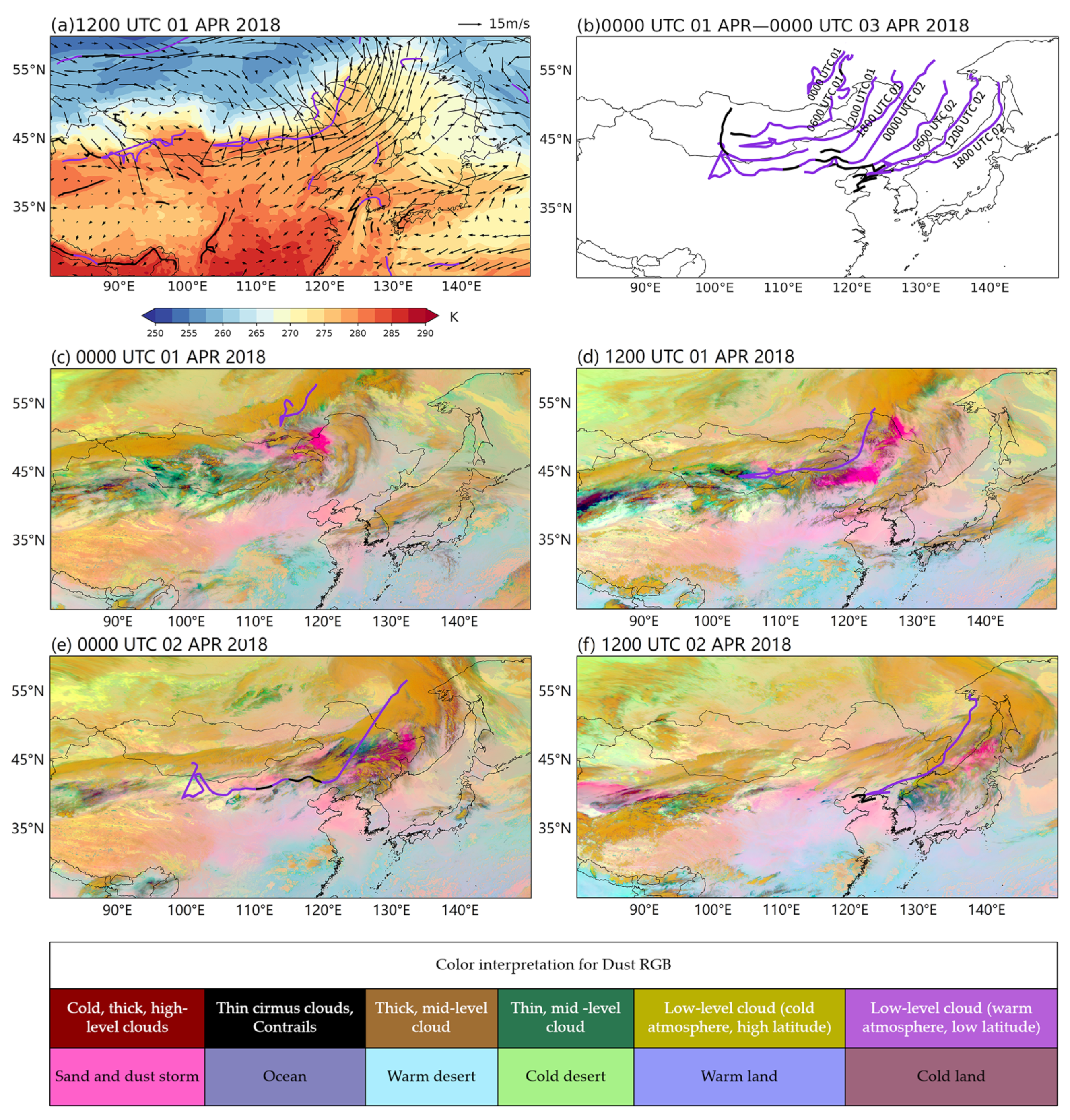

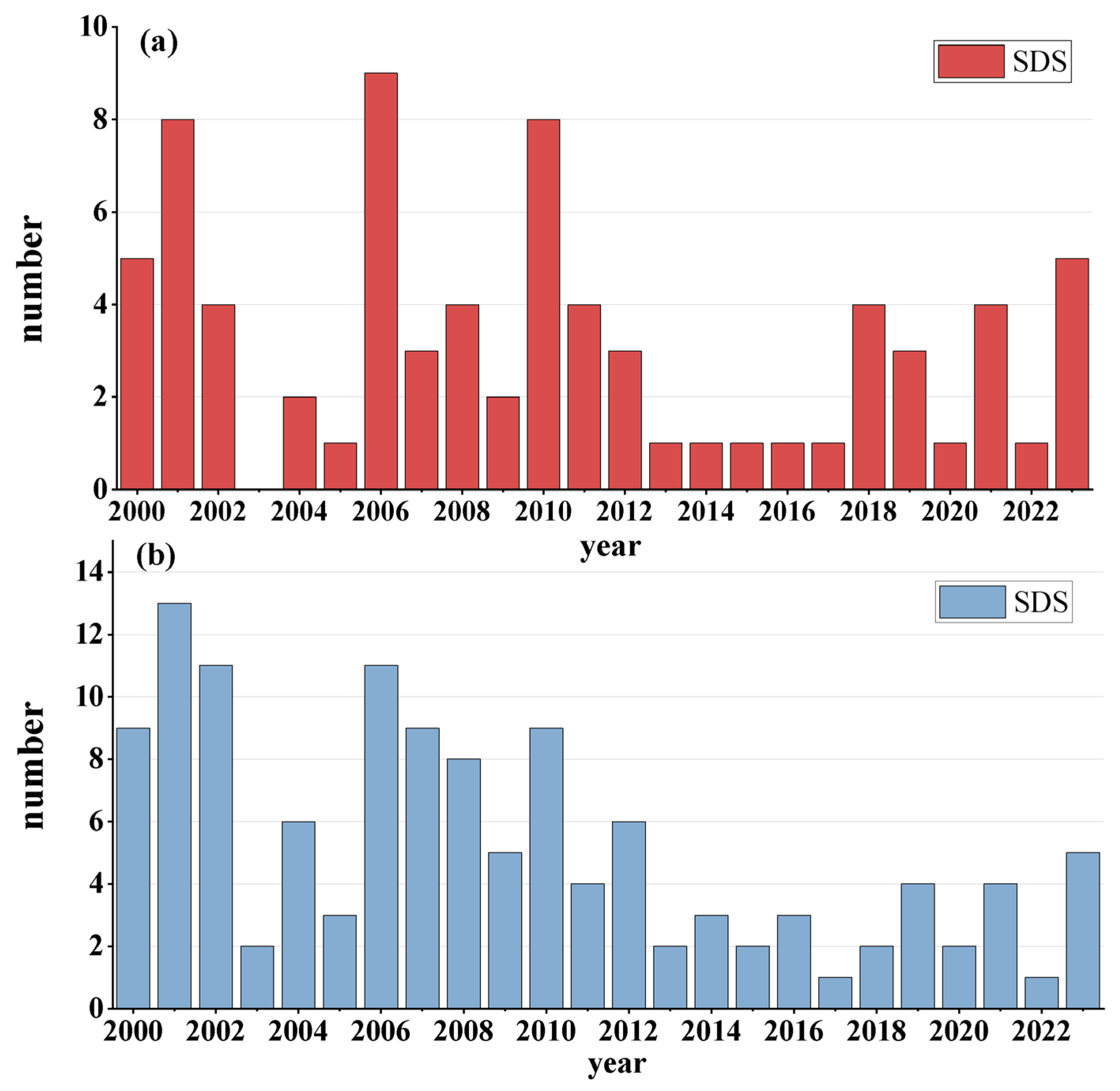
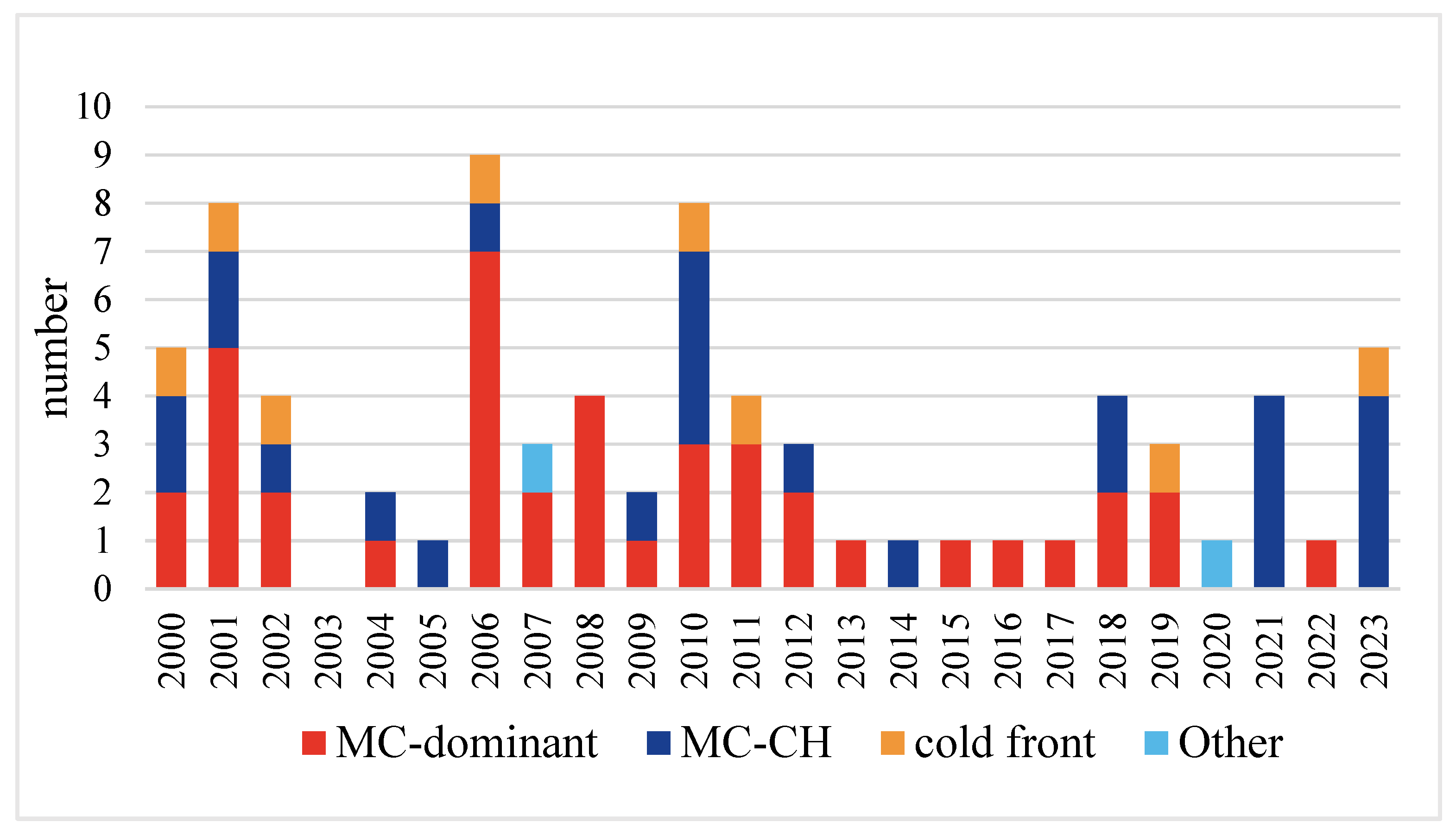
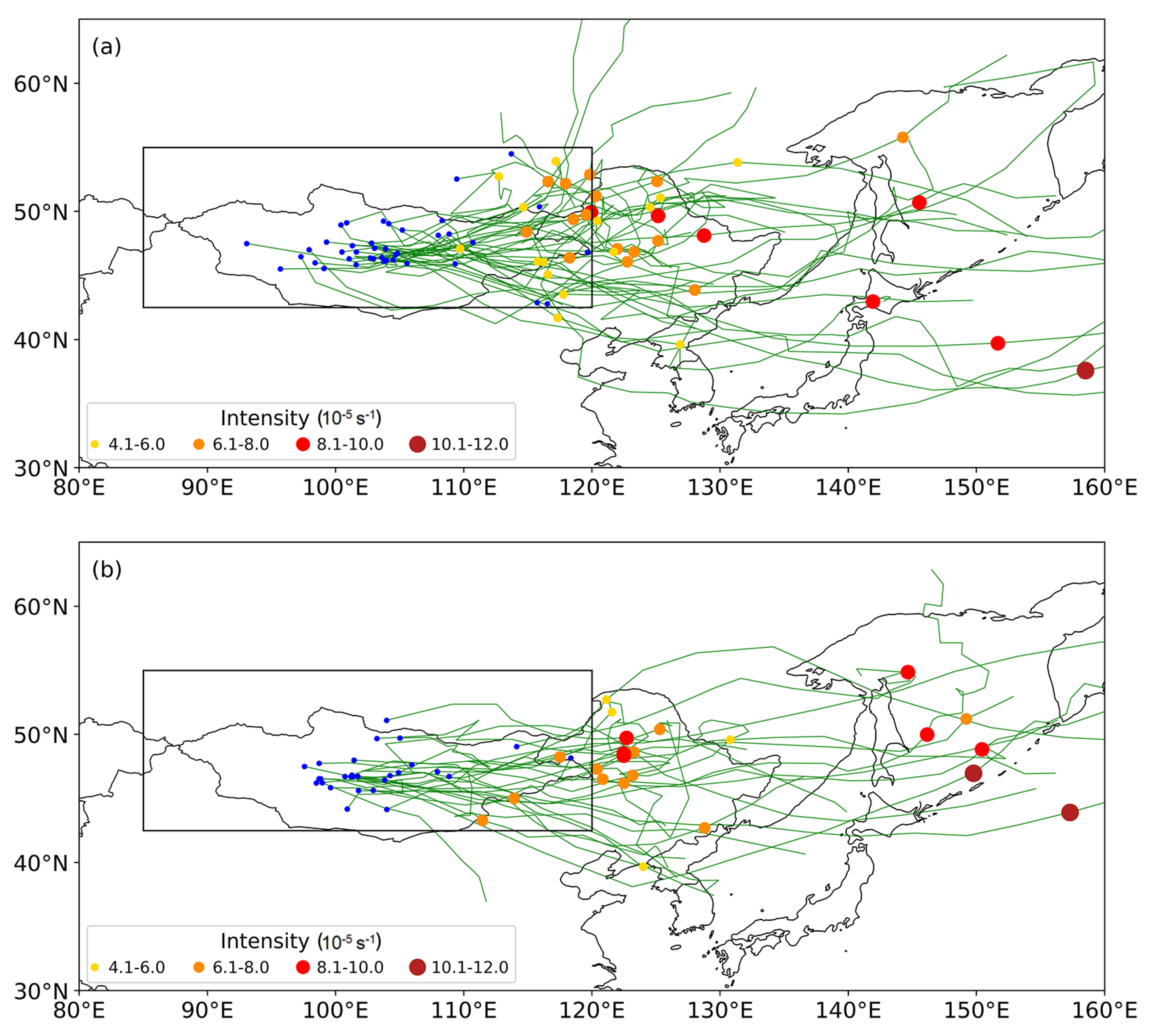
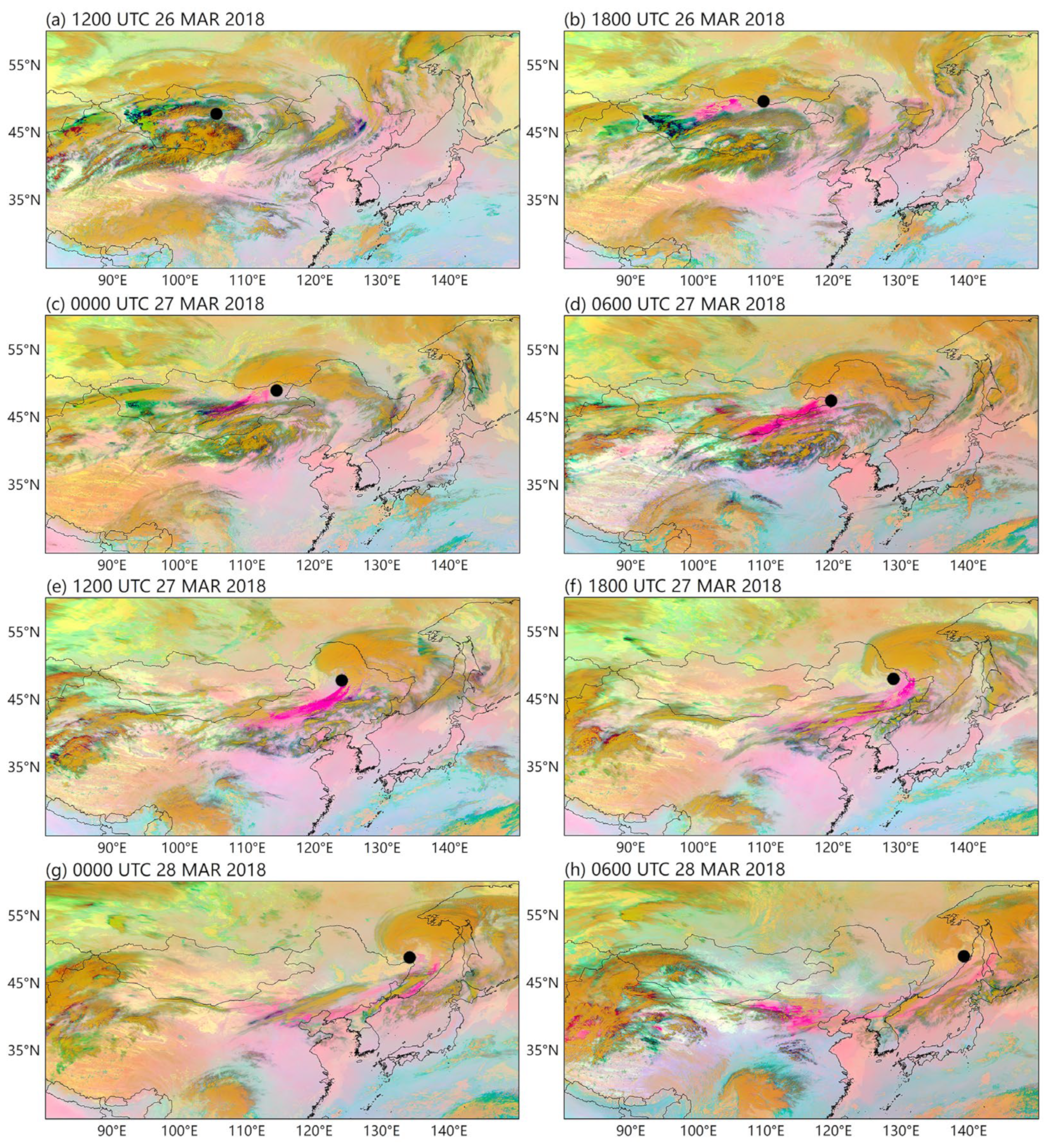


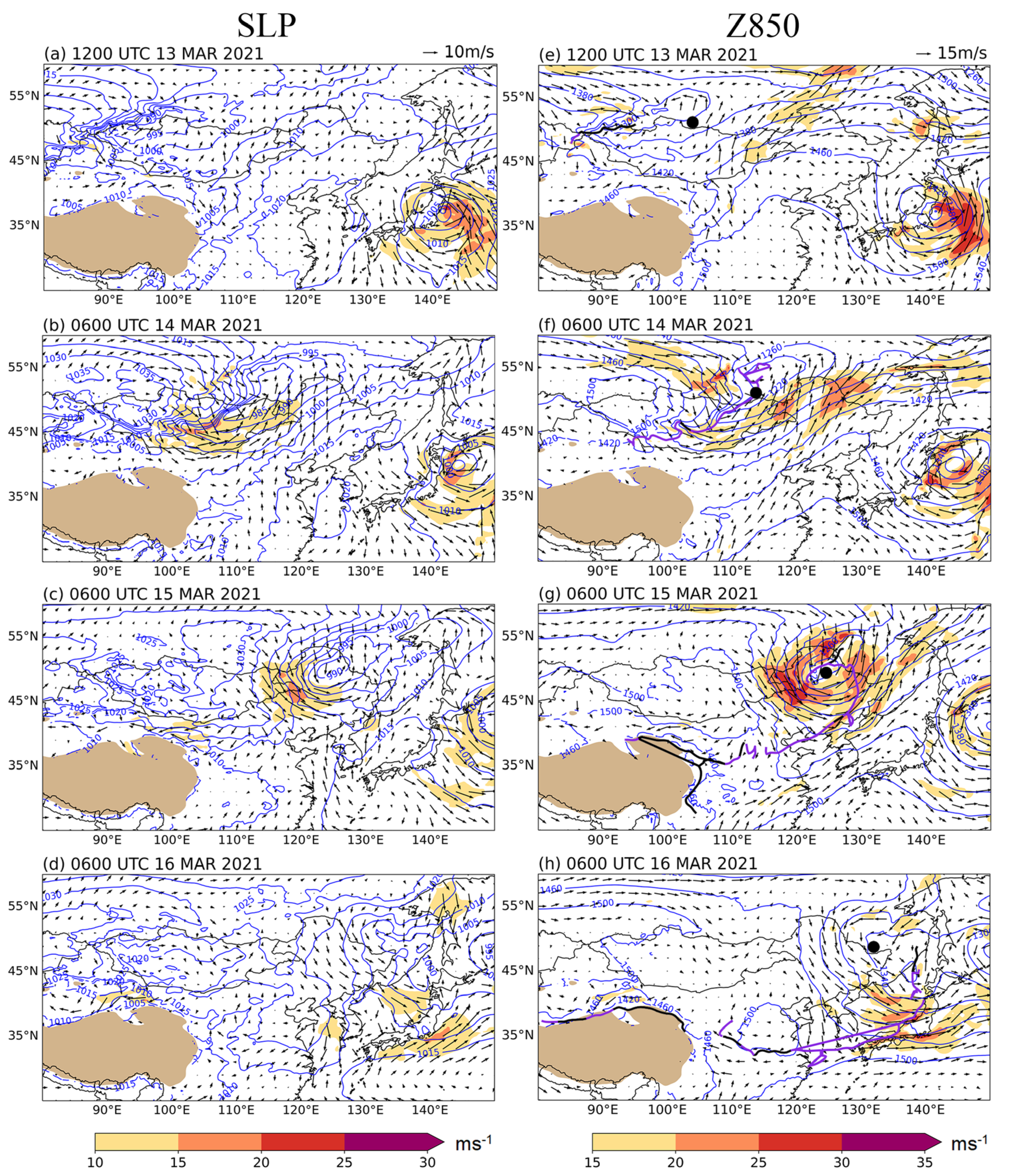
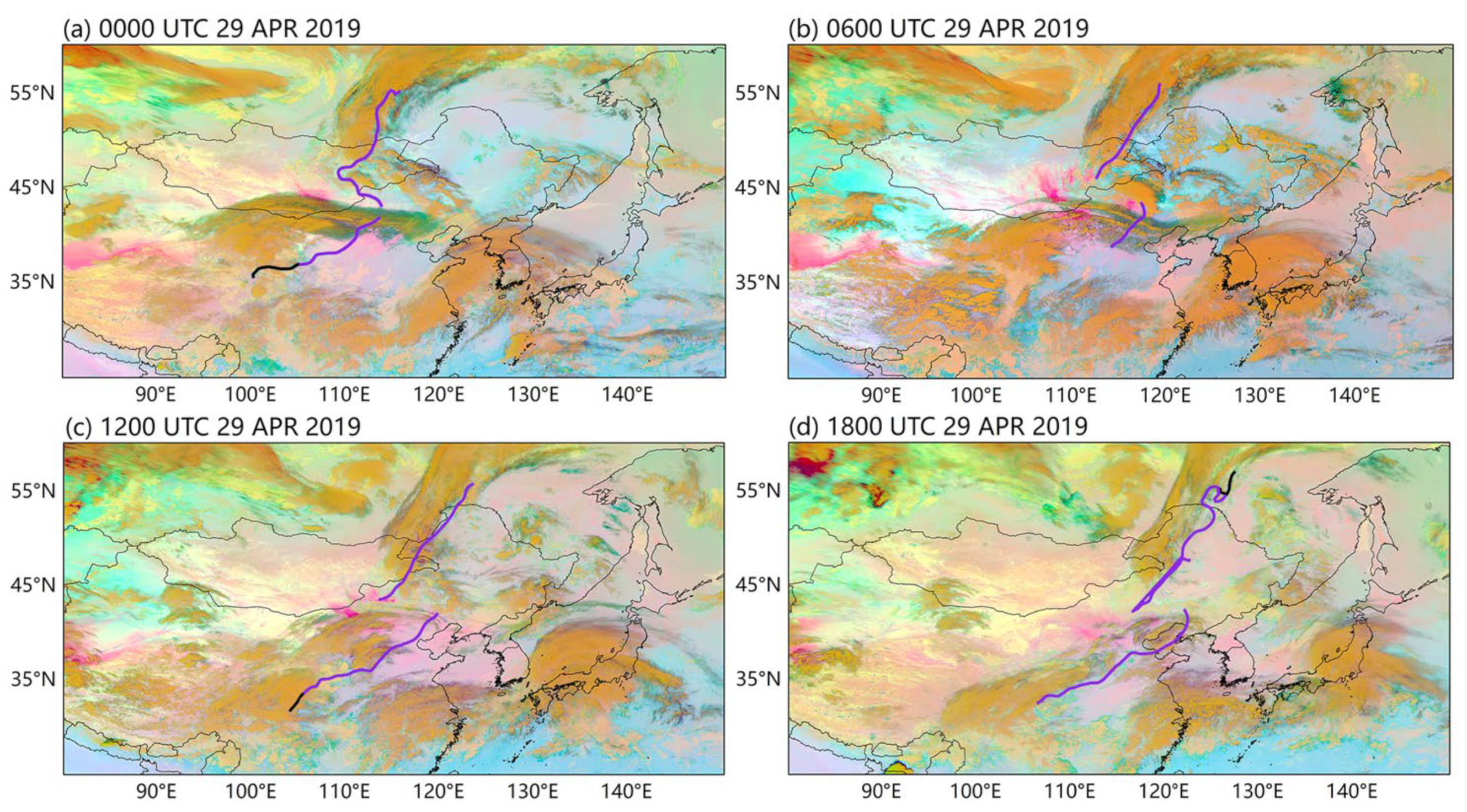
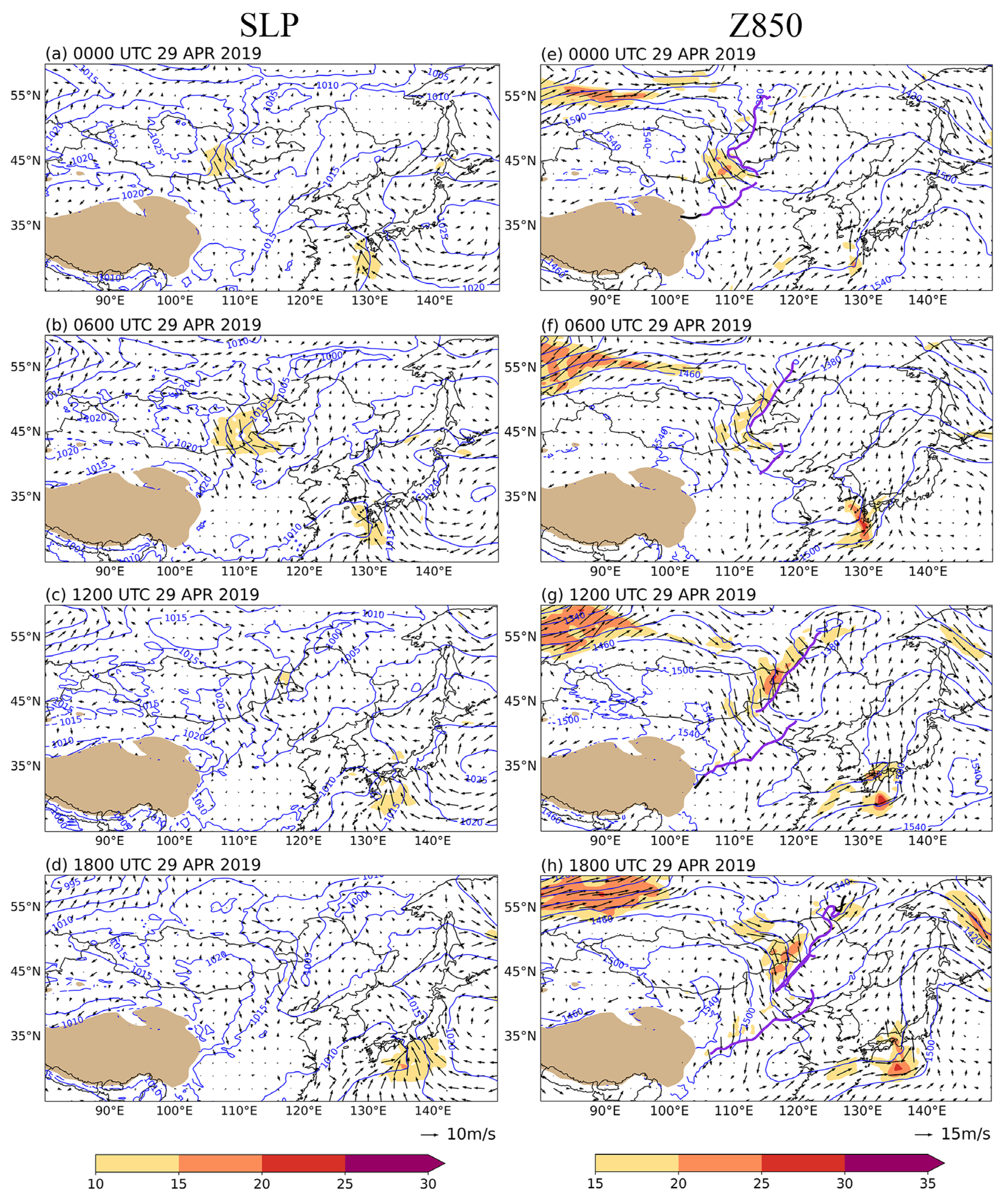
| Year | SDSs | Date |
|---|---|---|
| 2000 | 10 | 16–20 March, 21–23 March, 26–27 March, 05–08 April, 07–09 April, 12–14 April, 18–21 April, 23–26 April, 27–29 April, 10–11 May |
| 2001 | 13 | 04–06 March, 18–19 March, 21–22 March, 23–25 March, 02–05 April, 05–08 April, 07–10 April, 11–13 April, 22–23 April, 27 April, 28–30 April, 01–02 May, 03–04 May |
| 2002 | 11 | 15–17 March, 18–22 March, 24–25 March, 28–30 March, 30–31 March, 01–03 April, 05–09 April, 11 April, 13–17 April, 19–20 April, 21–24 April |
| 2003 | 2 | 08–11 April, 15–17 April |
| 2004 | 6 | 09–11 March, 26–28 March, 29–30 March, 22–25 April, 07–08 May, 18–19 May |
| 2005 | 3 | 27–28 April, 29 April–01 May, 09–10 May |
| 2006 | 11 | 09–12 March, 26–28 March, 05–07 April, 08–09 April, 09–11 April, 16–18 April, 21–23 April, 06 May, 10–11 May, 15–18 May, 29–30 May |
| 2007 | 9 | 27–28 March, 30–31 March, 31 March–03 April, 13–15 April, 19–20 April, 21–23 April, 08–11 May, 19–21 May, 22–24 May |
| 2008 | 9 | 14–15 March, 29–31 March, 17–21 April, 30 April–03 May, 06–08 May, 19–20 May, 26–28 May, 28–29 May, 17 March |
| 2009 | 5 | 09–12 March, 14–15 March, 16–19 April, 23–25 April, 28–30 April |
| 2010 | 11 | 01–03 March, 11–12 March, 19–22 March, 21–23 March, 28–29 March, 31 March–01 April, 07–08 April, 09 April, 19–20 April, 24–28 April, 05–08 May |
| 2011 | 5 | 12–14 March, 17–19 March, 04–05 April, 28–30 April, 10–12 May |
| 2012 | 6 | 20–22 March, 29–30 March, 01–02 April, 10–11 April, 18–19 April, 26–27 April |
| 2013 | 3 | 08–11 March, 17–18 April, 12–14 May |
| 2014 | 5 | 16–18 March, 23–24 April, 26–27 April, 08–09 May, 22–25 May |
| 2015 | 3 | 27 March, 31 March–01 April, 27–29 April |
| 2016 | 3 | 03–04 March, 30 April–01 May, 10–12 May |
| 2017 | 1 | 03–07 May |
| 2018 | 4 | 26–30 March, 01–03 April, 04–06 April, 12–15 April |
| 2019 | 6 | 19–24 March, 19–21 April, 26–28 April, 28–30 April, 11–12 May, 14–16 May |
| 2020 | 2 | 08–10 March, 10–11 April |
| 2021 | 4 | 13–18 March, 27 March–01 April, 14–16 April, 06–08 May |
| 2022 | 1 | 13–16 March |
| 2023 | 5 | 19–24 March, 09–13 April, 18–21 April, 27–29 April, 19–22 May |
Disclaimer/Publisher’s Note: The statements, opinions and data contained in all publications are solely those of the individual author(s) and contributor(s) and not of MDPI and/or the editor(s). MDPI and/or the editor(s) disclaim responsibility for any injury to people or property resulting from any ideas, methods, instructions or products referred to in the content. |
© 2024 by the authors. Licensee MDPI, Basel, Switzerland. This article is an open access article distributed under the terms and conditions of the Creative Commons Attribution (CC BY) license (https://creativecommons.org/licenses/by/4.0/).
Share and Cite
Borjigin, A.; Bueh, C.; Yong, M.; Purevjav, G.; Xie, Z. Cross-Border Sand and Dust Storms between Mongolia and Northern China in Spring and Their Driving Weather Systems. Remote Sens. 2024, 16, 2164. https://doi.org/10.3390/rs16122164
Borjigin A, Bueh C, Yong M, Purevjav G, Xie Z. Cross-Border Sand and Dust Storms between Mongolia and Northern China in Spring and Their Driving Weather Systems. Remote Sensing. 2024; 16(12):2164. https://doi.org/10.3390/rs16122164
Chicago/Turabian StyleBorjigin, Asia, Cholaw Bueh, Mei Yong, Gomboluudev Purevjav, and Zuowei Xie. 2024. "Cross-Border Sand and Dust Storms between Mongolia and Northern China in Spring and Their Driving Weather Systems" Remote Sensing 16, no. 12: 2164. https://doi.org/10.3390/rs16122164
APA StyleBorjigin, A., Bueh, C., Yong, M., Purevjav, G., & Xie, Z. (2024). Cross-Border Sand and Dust Storms between Mongolia and Northern China in Spring and Their Driving Weather Systems. Remote Sensing, 16(12), 2164. https://doi.org/10.3390/rs16122164







